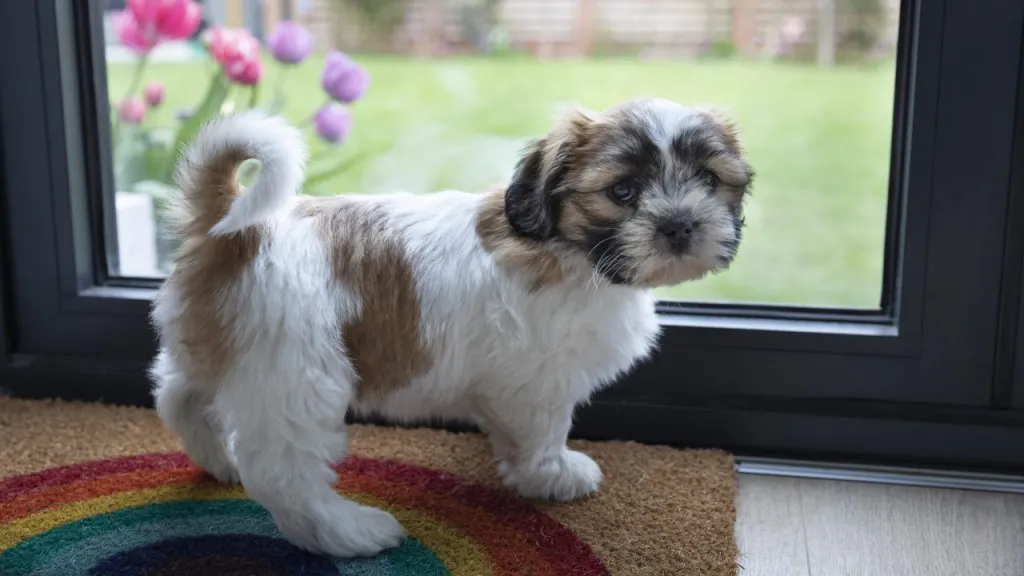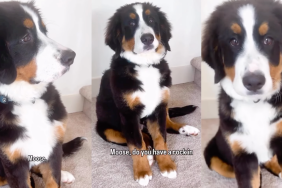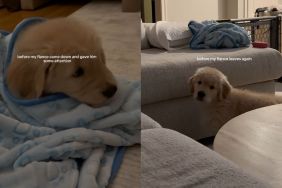One of the most daunting tasks for first-time puppy adopters is housetraining. By taking the right steps, you can make housetraining your puppy straightforward. Your rewards will be a cleaner home and a happier dog, so a little extra effort early-on is worth it.
Steps for housetraining your puppy
It’s important to stay consistent with training for the first few months of your puppy’s time in their new home. Crate training and using gated off zones, such as a kitchen or laundry room can also make potty training easier.
Take time off to housetrain your puppy
Housetraining will be quicker and easier if you start as soon as your pup comes home, then stick to it 24 hours a day. That’s one reason experts recommend taking off a week or two from work when you first get your pup. This time will also help you form lasting bonds with your puppy. If you’re working from home or have some time off work, use that time to start training off the right way.
Start using the crate right away
Crate training helps dogs learn bladder and bowel control because they don’t like soiling their sleeping and eating areas. Your dog’s crate should be large enough that they can comfortably lie down, but can’t soil one side and lie on the other. For large breed puppies, crates with removable dividers can help increase space as they grow.
The crate should not be used to keep your pup “out of sight, out of mind.” Give your puppy lots of breaks to stretch their legs and to play and bond with you. One or two hours at a stretch in the crate is all the time they should be spending there during the day. When not in use, leave the crate open to allow your puppy to go in and out freely.
Take your puppy outside frequently
The general rule of thumb is that a puppy can hold their potty for about one hour for every month of age they are. Puppies also need to potty after waking, eating and drinking, and playing. Never confine your puppy for longer than they can hold it. If you work during the day, you’ll need to hire someone to come to your house and let your puppy out.
Every dog is different, and smaller breeds can’t hold it as long as larger ones. If your pup soils their crate, then that may be a signal that they need more frequent bathroom breaks. And always watch for warning signs that they need to go. Clues include whining, pacing, circling, or sniffing the ground. If you see any of these distress signals, take your pup outside right away.
Stay consistent outside
Puppies and dogs learn through habit and will form substrate preferences depending on where you take them out to go. Use the same “elimination station” each time you take your puppy out for potty breaks.
Don’t distract your puppy with games and chit-chat; just stand still and let them circle and sniff. It can take easily distracted puppies a good 10-15 minutes before they realize what they should be doing. As soon as your puppy begins to go, give them a command, such as, “Go potty,” or “Do your business.” If your puppy refuses to go at all, take them back inside, wait a few minutes — or watch for signs they’re about to go — and then step back outside.
Shower them with treats and praise
Make sure treats and praise come right after your puppy finishes eliminating. Make the praise enthusiastic and the food treat top-notch. A piece of hot dog, some cheese, or a nibble of lunch meat only given when your puppy goes successfully can encourage them. You want to make it crystal clear that eliminating outside is a great thing.
Plan for middle-of-the-night potty runs
Puppies younger than four months will need a midnight potty break, so set your alarm. Keep nighttime bathroom runs calm and matter-of-fact, so your pup doesn’t think it’s playtime. If this isn’t enough to keep your dog from having accidents in the night, consider setting up a pen with a potty pad until your pup is able to hold it longer.
Clean up accidents right away
Accidents happen, even if you’re the best dog parent in the world. It’s important that you clean these up quickly and thoroughly so your puppy doesn’t feel drawn back to the same place by the smell of residual poop or urine. Use a cleaning product that contains live bacteria or enzymes that break down the mess, rather than masking it with another fragrance. This helps break down urine and stool particles that may attract your pup to go there again.
Things to avoid with housetraining
Now that you know what steps to take, there are some things you should also know not to do when housetraining your puppy.
Don’t punish your puppy
If you come home to find that your puppy had an accident, do not punish them. They will not connect their behavior with the punishment, so they won’t learn what they did wrong. In fact, your puppy may think you have a problem with poop and pee in general, which could lead to them feeling anxious about going potty at all. Even worse, they could develop neurotic behaviors like eating poop to hide it from you.
If you catch your puppy having an accident, startle them midstream with a quick shout or clap, and then hustle them outside to finish the job. Praise them when they’re done so they learn that eliminating outside isn’t just allowed, it’s generously rewarded.
Don’t use the wrong cleaners
Stay away from ammonia-based cleaners; they’ll smell like urine to your puppy, and they’ll want to pee again on the same spot. Also, stay away from products that contain bleach or harsh chemicals. These can harm your puppy.
Don’t leave your puppy unsupervised
If your puppy goes through most of the day unsupervised and outside of the crate, then they’re bound to have accidents. There’s no one around to catch them in the act or read the signs that they need to go out. Supervise your puppy as much as possible. Do not give them free access to all areas of your home if you can’t watch them. Limit your puppy to the room or area of the house where you can see them.
When housetraining isn’t working
Patience is key when it comes to housetraining. Not all dogs learn at the same pace, and puppies can take several months before they consistently go potty where they’re supposed to. Remember that your puppy isn’t punishing you, nor are they necessarily a slow learner if they have accidents. You may simply have missed their signs that it was time to go.
However, if you feel that housetraining isn’t working despite your best efforts, then there may be something wrong.
Health problems
Many health issues can result in dogs peeing or pooping more than usual, and other medical conditions prevent dogs from going potty enough. It’s not uncommon for a urinary tract infection or some other ailment to make housetraining next to impossible. Keep up with regular vet visits to detect any health concerns early.
Being inconsistent with the rules
While you shouldn’t punish your puppy for accidents, you shouldn’t coddle them too much either. For example, if you carry your dog outside like a baby instead of walking them out, they may refuse to go outside unless you hold them. It’s also important to stick to a strict routine. This can help both you — and your puppy — know when it’s the most likely time to run out for a potty run.
Housetraining a new puppy doesn’t have to be difficult, but it does take patience. If you’re looking for more information on taking care of a new puppy, check out some tips to puppy-proof your home. Or, teach your new pup some great skills with these fun tricks.









